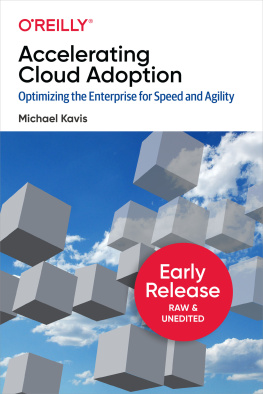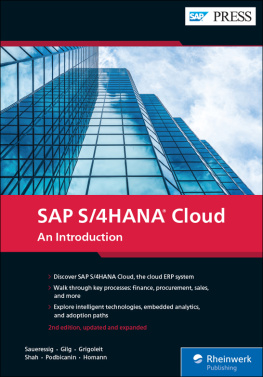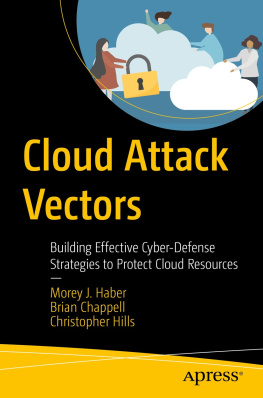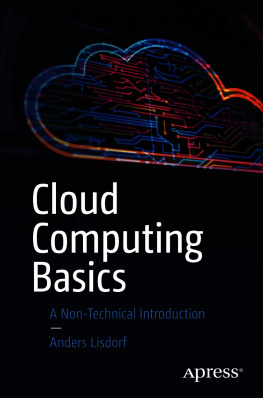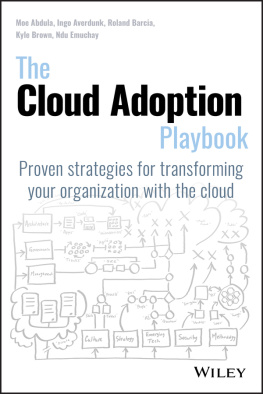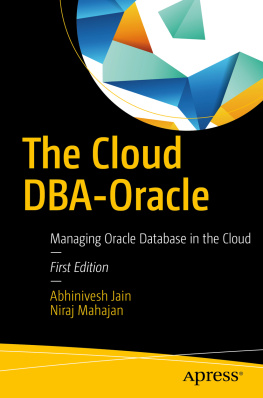Michael Kavis - Accelerating Cloud Adoption
Here you can read online Michael Kavis - Accelerating Cloud Adoption full text of the book (entire story) in english for free. Download pdf and epub, get meaning, cover and reviews about this ebook. year: 2020, publisher: OReilly Media, Inc., genre: Business. Description of the work, (preface) as well as reviews are available. Best literature library LitArk.com created for fans of good reading and offers a wide selection of genres:
Romance novel
Science fiction
Adventure
Detective
Science
History
Home and family
Prose
Art
Politics
Computer
Non-fiction
Religion
Business
Children
Humor
Choose a favorite category and find really read worthwhile books. Enjoy immersion in the world of imagination, feel the emotions of the characters or learn something new for yourself, make an fascinating discovery.
- Book:Accelerating Cloud Adoption
- Author:
- Publisher:OReilly Media, Inc.
- Genre:
- Year:2020
- Rating:5 / 5
- Favourites:Add to favourites
- Your mark:
- 100
- 1
- 2
- 3
- 4
- 5
Accelerating Cloud Adoption: summary, description and annotation
We offer to read an annotation, description, summary or preface (depends on what the author of the book "Accelerating Cloud Adoption" wrote himself). If you haven't found the necessary information about the book — write in the comments, we will try to find it.
Accelerating Cloud Adoption — read online for free the complete book (whole text) full work
Below is the text of the book, divided by pages. System saving the place of the last page read, allows you to conveniently read the book "Accelerating Cloud Adoption" online for free, without having to search again every time where you left off. Put a bookmark, and you can go to the page where you finished reading at any time.
Font size:
Interval:
Bookmark:

by Michael Kavis
Copyright 2020 Michael J. Kavis. All rights reserved.
Printed in the United States of America.
Published by OReilly Media, Inc. , 1005 Gravenstein Highway North, Sebastopol, CA 95472.
OReilly books may be purchased for educational, business, or sales promotional use. Online editions are also available for most titles ( http://oreilly.com ). For more information, contact our corporate/institutional sales department: 800-998-9938 or corporate@oreilly.com .
- Editors: Jennifer Pollock and Sarah Grey
- Production Editor: Caitlin Ghegan
- Copyeditor: Sonia Saruba
- Proofreader: Carol Keller
- Indexer: Cheryl Lenser
- Interior Designer: Monica Kamsvaag
- Cover Designer: Randy Comer
- Illustrator: Kate Dullea
- December 2020: First Edition
- 2020-06-25: First Early Release
- 2020-09-25: Second Early Release
- 2020-11-16: Third Early Release
See http://oreilly.com/catalog/errata.csp?isbn=9781492055952 for release details.
The OReilly logo is a registered trademark of OReilly Media, Inc. Accelerating Cloud Adoption, the cover image, and related trade dress are trademarks of OReilly Media, Inc.
The views expressed in this work are those of the authors, and do not represent the publishers views. While the publisher and the authors have used good faith efforts to ensure that the information and instructions contained in this work are accurate, the publisher and the authors disclaim all responsibility for errors or omissions, including without limitation responsibility for damages resulting from the use of or reliance on this work. Use of the information and instructions contained in this work is at your own risk. If any code samples or other technology this work contains or describes is subject to open source licenses or the intellectual property rights of others, it is your responsibility to ensure that your use thereof complies with such licenses and/or rights.
978-1-492-05595-2
Lightning Source
I am privileged to be able to write the foreword to Mike Kavis second book. In early 2014, while leading the global cloud transformation for a multi-national financial services firm, I personally purchased two dozen copies of Mikes previous book, Architecting the Cloud: Design Decisions for Cloud Computing Service Models. I freely handed out copies to the members of the CIO Council that governed all technology programs at the bank. I also gave copies to all of the managing directors who reported to me in the Office of the CTO, and to senior leaders in the technology organizations supporting the corporate, consumer and capital markets businesses. This was the first time most of these leaders were introduced to concepts such as Infrastructure-as-a-Service and Platform-as-a-Service. I advised my colleagues to read just the first seven chapters, particularly Chapter Three: Cloud Computing Worst Practices. The goal of that recommendation was to make everyone aware of what not to do, before we embarked on a journey to architect and enable a global private cloud with IaaS and PaaS services models. Enthusiasm for the new-new thing often has to be mitigated by an up-front recognition that there are always complex risk tradeoffs associated with any technology transformation, and some words of wisdom by Mike Kavis, who had gone down the path before, was advice to be well considered.
In this book I see the same wisdom and caution offered for how cloud operating models are the essential element to figure out and get right before embarking on a public cloud or a multi-cloud journey. I have spoken many times to customers and in various public forums about the concepts of Cloud Economics, Cloud Speed, Cloud Scale and Cloud Safety & Security. These are all key architectural and operational objectives for any cloud, whether private, hybrid, public, edge or multi-cloud. The goal is to accurately quantify the economic tradeoffs of capex and opex, enable faster speed of delivery of infrastructure and applications, have the ability to scale up/down and/or scale out/in dynamically, while all the time ensuring that resiliency, safety and soundness are preserved through end-to-end security, resiliency and disaster recovery policies and mechanisms. What is common to all of these goals is achieving maturity in cloud operating models, and the people, processes and technologies that all have to come together to achieve a level of operational maturity to enable the desired business outcomes.
The analogy Mike makes with the evolution of power utilities in the early part of the 20th century is apropos for the type of technology transformation to utility-like consumption models for infrastructure and software services. However, moving electrons around is actually much simpler than moving complicated application workloads and their data to a cloud consumption-based operating model from a traditional enterprise ITcost-managed operating model. And the reality for most customers is that it is not an all-or-nothing proposition, but some combination of a private, hybrid, public, and Co-Lo cloud model based on a complicated set of application and business risk-management constraints, as well as the economics, speed, scale, reliability and security tradeoffs mentioned above.
Cloud computing models offer significant opportunities for businesses to enable new types of services, delivered at a velocity and scale previously unimagined. The key enabler is all the software, much of it originating in the open source community, that is able to deliver very high degrees of automation, both by the cloud providers in delivering their services and by the cloud consumers delivering applications built on those services. There is however an element of risk concentration that must be given due consideration. Just as electrical power utilities can incur planned or unplanned outages affecting millions of users, risk concentration of applications and services in public cloud utilities can incur outages as they usually offer only 99.9% reliability of the infrastructure. You have to bring your resiliency models along with your applications when you make the journey to the cloud. No application is an island unto itself and usually has an ecosystem of services that provide the essential life support mechanisms that application teams have come to rely upon. Many application developers do not fully understand resiliency the way that outage-hardened IT infrastructure people do, so they have to work together as a joint team, which may not be a natural tendency. The later chapters of this book dig into the operational models that enable you to ensure that operational resiliency and recoverability are part of the cloud strategy, planning and operating model. Site reliability engineering models are a key part of the process to achieve high degrees of resiliency in a cloud world. Just as I did when recommending Mikes first book to my former colleagues, I strongly recommend you read to at least Chapter Seven: Cloud Operations and Reliability, so that you understand the failure models and what you can do to avoid them.
Greg Lavender, Ph.D.
SVP & CTO
VMware, Inc.
Palo Alto, CA
The purpose of this book is to help enterprise leaders develop plans to accelerate cloud adoption in their organizations. Adopting cloud computing is a transformation for most organizations. You cant just plug your old processes directly into the cloud and expect to succeed; everyone in your enterprise, inside and outside IT, will need to adapt a new mindset. As a leader, you will spend a lot of time explaining why change is necessary. Youll need to create a clear vision of what good looks like that others can follow.
Font size:
Interval:
Bookmark:
Similar books «Accelerating Cloud Adoption»
Look at similar books to Accelerating Cloud Adoption. We have selected literature similar in name and meaning in the hope of providing readers with more options to find new, interesting, not yet read works.
Discussion, reviews of the book Accelerating Cloud Adoption and just readers' own opinions. Leave your comments, write what you think about the work, its meaning or the main characters. Specify what exactly you liked and what you didn't like, and why you think so.

